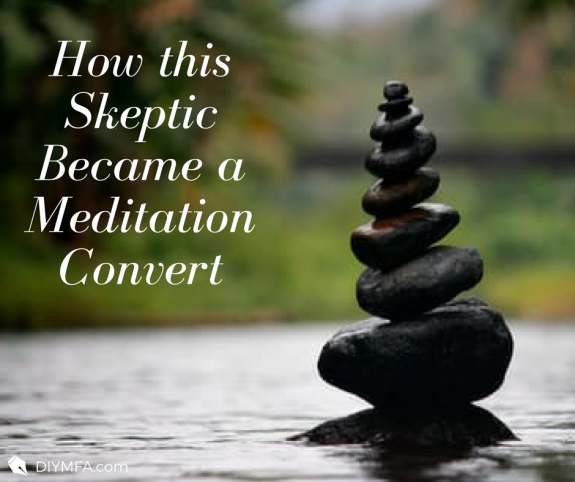Breathe in… I wonder who’s the guest on The Daily Show tonight?
Breathe out… I really liked Trevor Noah’s memoir. I should recommend it to my book club.
Breathe in… Focus! You’re supposed to be clearing your mind.
Breathe out… What should I make for supper tonight?
If you’ve tried meditation, does this sound familiar? When I first tried meditation, I found myself on an endless loop of random thoughts, alternating with reminders that I was supposed to be emptying my mind, followed by maybe three seconds of Zen-like focus, and then back to thinking about plans for the day. When the alarm went off for the end of my session, I felt more unfocused and mixed up than when I’d sat down, plus I needed to find a pen and paper to write down all the thoughts and plans that had occurred to me during the session. I was frustrated. I’d read books and articles about meditation and participated in guided versions at the end of yoga class. I was checking off all the boxes: quiet space, dedicated time, focusing on the breath. But it just wasn’t working.
After several failed attempts, I decided that I wasn’t a meditator. I used plenty of excuses:
- I don’t like to sit still.
- I don’t have time.
- I’d rather take a nap.
- My brain is just fine, thank you.
My most elaborate excuse involved my writing. I reasoned that as a writer, and particularly a dedicated journal writer, I was already dumping all of my extraneous thoughts and feelings on paper, and therefore giving my mind a daily deep clean. Writers don’t need meditation, I decided. (Oh, how I was kidding myself!)
The Evidence Piles Up
But I couldn’t ignore all the evidence that vaunted the power of meditation. Through books, articles and stories from friends, I learned that meditative practice can be the solution to a bounty of twenty-first century problems: anxiety, depression, sleep problems, lack of focus, stress, even weight gain. It can make you happier and more conscious of how you treat your body. And all without chemicals or side effects! I also couldn’t ignore the fact that I seemed to crave the peace that meditation provided: whenever I skipped yoga class, I deeply missed that calming, empty space of savasana (the “corpse pose” that concludes each class).
I was convinced by the science and the anecdotal evidence, and I wanted to try again. But I still had a problem: I wasn’t naturally good at meditating, and I didn’t know how to get better.
Meditation: Next Attempt
I needed a little nudge, and it finally came in early January this year, when I started feeling symptoms of Seasonal Affective Disorder. This happens to me every year, but it was particularly bad this year because I was home a lot more often, taking care of my two-month-old baby. Lack of sunshine and social activity was making the SAD hit harder than ever. I did all of my usual interventions, including using a light therapy box and getting extra sleep, but I was still feeling emotionally ragged. It seemed like a good time to try meditation again and see if I could do it well enough to get all those health benefits I’d been reading about.
I started using the Headspace app. I’d bought a subscription the year before, did the first several sessions, then stopped after the practices got longer and longer. This time, I browsed the app further and found the creativity track, thirty days of creativity-focused guided meditations. Best of all, I could choose the length of my practice, anywhere from ten to thirty minutes. Relieved that I wouldn’t have to find a big chunk of time every day, I went with ten minutes.
I immediately remembered why I’d liked Headspace in the first place. I’d tried meditating without prompts, and it was extremely difficult to keep my mind clear. With Headspace, the occasional narration keeps me on track and also gives me an image to focus on. I don’t only count my breaths for ten minutes; I also create a picture in my mind’s eye, and use that to inform my practice for the day.
Just as in the past, the first several sessions were hard. My mind went off in a hundred directions, and I felt like I only got a minute or two of real clarity. But one day, a funny thing happened. I conjured the image that the Headspace narrator had been guiding me toward each day, and without any apparent mental effort, the image changed. It grew and evolved, becoming something more complex and beautiful. For the first time, I felt connected to a greater source. Whether it was external or internal, I don’t know, but I finally was a believer: meditation was changing my brain for the better.
I’m A Believer
I’m still meditating most days of the week, working with the creativity track. I’m enjoying the sessions more each time. It excites me to plunge into the depths of my creative mind and see what comes of it. I emerge each time feeling refreshed and focused, ready to tackle my work. Outside of the meditation practice, I’m finding other benefits. I’m falling asleep more easily, staying in the moment while playing with my kids, and even losing weight. Most importantly, when I sit down to write, the words are coming faster because the creative insights have already been teased out in my brain.
Have you tried meditation? Do you think it’s helped you and your writing life? Share your meditation stories with me!
 Leanne Sowul is a writer and teacher from the Hudson Valley region of New York. She’s the curator of the website Words From The Sowul and authors the “Be Well, Write Well” column for DIY MFA. She writes historical/literary fiction and memoir; her work is represented by Suzie Townsend at New Leaf Literary Agency. Connect with her at leannesowul(at)gmail(dot)com, or on Twitter @sowulwords.
Leanne Sowul is a writer and teacher from the Hudson Valley region of New York. She’s the curator of the website Words From The Sowul and authors the “Be Well, Write Well” column for DIY MFA. She writes historical/literary fiction and memoir; her work is represented by Suzie Townsend at New Leaf Literary Agency. Connect with her at leannesowul(at)gmail(dot)com, or on Twitter @sowulwords.







